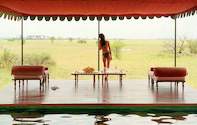
Botswana is a year round wildlife destination, but there are certain seasons that are more suitable for special interests than others are.
The following information is offered as a guideline, as weather patterns and wildlife rhythms are never predictable and can never be guaranteed at a specific time or in a specific area.
For Birding: October to March
The first migrants arrive from the Northern Hemisphere during September. By December all the migrants have arrived which means there are 20% more birds in Botswana during the summer months, compared to the winter months.
The Okavango Delta is a veritable birders dream with scope for the experienced ornithologist as well as the eager amateur. One of the highlights of the birding calendar takes place during September / October when the carmine bee-eaters arrive from Central Africa. They are frequently seen in their hundreds on the Savute Marsh.
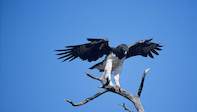
Due to the heronry being shared by a variety of species, it is active from July to March and is at its busiest from September to December when breeding colonies of herons are joined in the shallows, and among the low trees and swamp-fig thickets, by Marabou, Yellow and Saddle-billed storks, sacred Ibis and Egrets. Flapping, noisy, colourful breeding displays can be enjoyed at close quarters.
During the rainy season, the desolate landscape of the Makgadikgadi Pans is transformed into a magical wildfowl habitat as a sheet of water a few centimetres deep covers it.
An amazing extravaganza of reflected pink and white unfolds as flocks of Flamingo, Pelicans, ducks, geese and other migratory birds arrive in their thousands to feed on the algae and minute crustaceans that the rains have enticed out of their underground nursery.For Botany: December to May
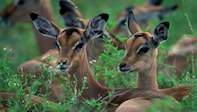
For Wildlife
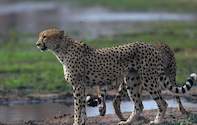
When the summer rains start towards the end of November the barren looking earth of Savute comes alive. Its rich new grasses are a magnet for herds of Burchell's Zebra and Wildebeest, which can be found on the Savute marsh where they foal before making for the lush grazing grounds of the Mababe Depression further south.
As the rains cease towards the end of February and the pans vaporise as the dry season looms the herds gather once again. Closely followed by predators, they make their annual journey from Savute to the Linyanti and Kwando rivers to arrive around April.
During the winter months, the banks of the Chobe, Kwando and Linyanti rivers become the lifeblood of the wildlife, as there is no surface water in the surrounding bush. Elephant and Buffalo are also migratory, making seasonal movements of up to 200km from the Chobe, Kwando and Linyanti Rivers, as they concentrate in the pans in the Mopane woodlands to the south, where there is a sufficient food.Makgadikgadi and Nxai Pan National Park
As the food and water source of the rolling grasslands west of Ntwetwe Pan begins to diminish during the winter months herds of Blue Wildebeest, Burchell's Zebra and other antelope gravitate in their hundreds to the perennial pools of the Boteti River, on the western boundary to the park.Depending on the rains, the build up takes place gradually from about mid March to May and over the next few months visitors could be lucky enough to witness the congregation of thousands of animals, along with the ever-opportunistic predators that follow them (September and October are the best months).
As soon as the summer rains arrive, the herds are no longer dependent on the river and they begin to disperse north and south before returning to the Boteti River once again when the rains diminish.
For Photography
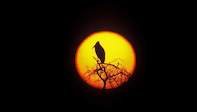
Climate
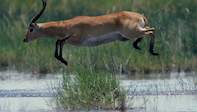
Summer: October to March. In October, the weeks preceding the coming of the rains tend to be the hottest with temperatures soaring up to 40ºc or more. Cloud coverage and the arrival of the first rains towards the end of November or in early December cool things down considerably, although usually only for a short period.
During the rainy period, which lasts until the end of February or early March, the days are hot and generally sunny in the morning with afternoon thunderstorms - usually in short, torrential downpours during the late afternoon. Daytime temperatures can rise to 38ºC and nighttime temperatures drop to around 20ºC - 25ºC.
Northern areas receive up to 700mm of rain per annum while the Kalahari Desert area averages as low as 225mm per annum. Rainfall tends to be erratic, unpredictable and regional. Often a heavy downpour may occur in one area while 10 or 15 kilometres away there is no rain at all. Showers are often followed by strong sunshine so a good deal of the rainfall does not penetrate the ground, as it is lost to evaporation and transpiration.Winter: April to September. The days are dry, sunny, clear, and range from cool to seductively warm, while evening temperatures drop sharply. Daytime temperatures generally reach 20º C and evening temperatures can be as low as 5ºC and in some areas can plummet below freezing. Virtually no rainfall occurs during the winter months.
 Year round, you'll find something remarkable to do and experience in this land of contrasts. Each season in Botswana has its attractions...
Year round, you'll find something remarkable to do and experience in this land of contrasts. Each season in Botswana has its attractions... Quite simply, there's nowhere quite like it. Wildlife, wilderness and sense of wonder. Botswana has it all. This is more than just another s...
Quite simply, there's nowhere quite like it. Wildlife, wilderness and sense of wonder. Botswana has it all. This is more than just another s...